How to manage Self-Phase Modulation (SPM) in CPA-Based Ultrafast lasers
On: Jul 22, 2021
In: Ultrafast Lasers
Chirped-Pulse Amplification (CPA), based on ultrafast lasers (Fig. 1), are in-demand versatile processing tools. They often operate in extreme physical conditions: several hundred Watts to Kilowatts of average power in MHz-GHz repetition rate regime, combined with pulse duration often below a picosecond, give rise to intense pulse in MW to GW peak power. Ultra-Short Pulse (USP) lasers are becoming a vital backbone in diverse applications. Whether it is for micro-machining processes (from microelectronics to the flat panel industry), surface functionalization or even extreme physical processes, such as Terahertz generation or high harmonic generation (HHG), these types of applications require increasingly short and energetic pulses.

Fig. 1: Chirped-pulse amplification chain
Industrial lasers are expected to generate a distortion-free, high peak-power pulse delivered to the target, for any power regime and any energy level, that is stable over time and delivered on-demand. While it is possible to use lasers at fixed repetition rates and energy per pulse, most industrial applications require a tuning of the repetition rate or the use of burst modes to maximize throughput.
Increasing Power Requirements
Lately, there has been an increasing demand for ultrashort pulses propelling large-scale and high-speed material processing. These high-end applications require more energy from the amplifiers, most often resulting in higher peak power within the gain medium and triggering non-linear effects. Self-Phase Modulation (SPM), through the well-known Kerr effect, is the first manifestation of non-linear effects. It will distort the phase of the pulse, reducing its compressibility, thus lowering its peak power.
Increasing Mode Field Diameter (MFD)
Of course, SPM can be reduced by lowering the pulse intensity through the CPA chain. Reducing the peak intensity in the amplifier by increasing the beam diameter is an obvious choice to lowering non-linear effects. However, its implementation is not always straightforward, especially in fiber, whereby maintaining a single mode propagation is required. In large mode area fibers, more complex schemes are needed to remain in this single mode regime, involving very specific packaging and more expensive fiber designs.
Greater Stretching Factor
Stronger temporal broadening also helps to increase the extracted energy from the amplifier. Indeed, for a given peak-power limit, longer pulses through the amplifier will draw more energy from the amplification chain, which is usually limited by the pulse intensity rather than the energy available from the gain media. To do so, longer or multiple CFBGs must be used, along with higher groove density or bulkier grating compressors.
Compressor Tuning
Despite the CPA design, operating in a high non-linear regime is required for many applications. As mentioned in the introduction, these lasers will then have to change their repetition rate from the fundamental repetition rate of the oscillator up to single shots. The available energy per pulse will then vary greatly, impacting the non-linear phase-shift accordingly. To minimize the SPM distortions on the output pulse, a tuning of the compressor is the usual practice among manufacturers. Even though they can allow significant changes in 2nd order dispersion, compressors provide only a very limited tuning range over the 3rd order dispersion. However, SPM is not limited to simple 2nd and 3rd order dispersion as it depends on the pulse spectral amplitude shape. The spectral content is affected by the gain shape of the amplifier and amplitude filtering of various components in the system.
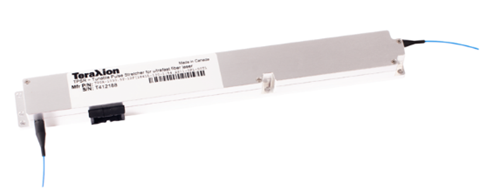
Chirped Fiber Bragg Gratings (CFBG): A Recent but Mature Technology
Tunable CFBGs (Fig. 2) offer five degrees of liberty of dispersion tuning—up to the 5th order of dispersion—while stretching the pulse to several hundreds of picoseconds. This makes them an attractive solution for high-energy and versatile pulse shapping in industrial ultrafast lasers. While reducing the peak intensity through the amplifier chain, the tunable chirped fiber Bragg grating pulse stretcher helps minimize detrimental SPM effects. Tunable CFBGs benefit every type of amplifier, fiber, and solid-state. Ultrafast lasers equipped with tunable CFBGs are capable of operating at various repetition rates, hence various energies and Self-Phase Modulation levels without any compressor adjustments.
Investigation on the Impact of Self-Phase Modulation on Different Pulse Spectral Profiles
The impact of the non-linear effect is dependent on the pulse spectral shape. The following simulation results will show the behavior of a Gaussian and a Parabolic pulse (Fig. 3) experiencing various levels of a non-linear phase shift with B-integral ranging from 0 to 15 radians.

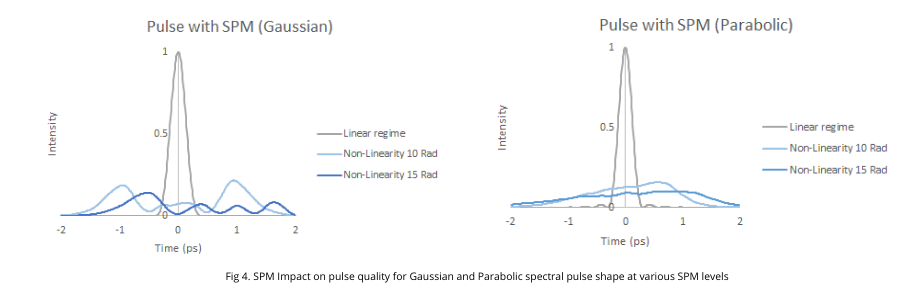
Using a simple model to estimate the impact of the accumulated phase from SPM, Fig. 4 and Fig. 5 show, respectively, how the temporal shape and spectral group delay are distorted by SPM up to a B-integral of 15 rad. It is obvious that both pulse types behave quite differently under the non-linear effects.
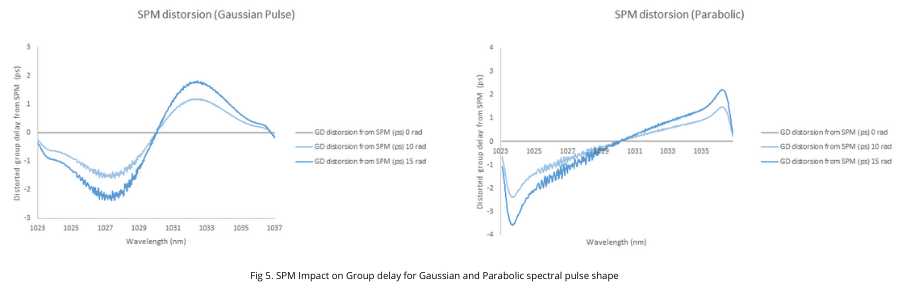
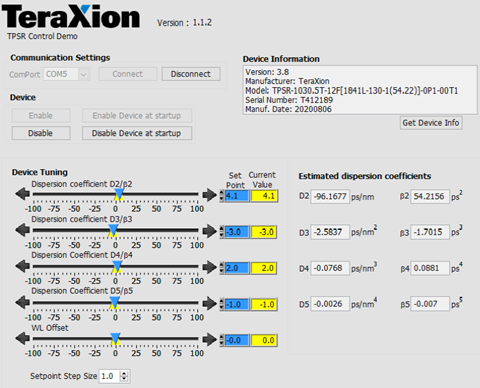
Fortunately, laser pulse shapping is possible using tunable CFBGs. The CFBG technology is already a gold standard used for pulse stretching, being the first building block of the CPA architecture. Without the addition of any components, tunable CFBGs are used as a pulse stretcher and an efficient fine-tuning knob that can precisely compensate the group delay variation associated with SPM. Fig. 6 below presents the possible degree of freedom available and its corresponding lab interface. A series of commands from a I2C protocol can also be used for direct machine communication.
Fig 6. Software Interface provided for RD or manufacturing purpose
The applied correction on group delay for both examples is shown in Fig. 7, while Fig. 8 shows the corresponding corrected compressed pulses. Commercially available CFBGs allow the tailoring of the group delay function; the correction is effective up to the 5th order of dispersion, which results in high-quality pulses. Fig. 8 also compares the compensation of SPM by the compressor and the tunable CFBG. The limits of SPM compensation by the compressor are easily noticeable, especially for the Gaussian pulse.
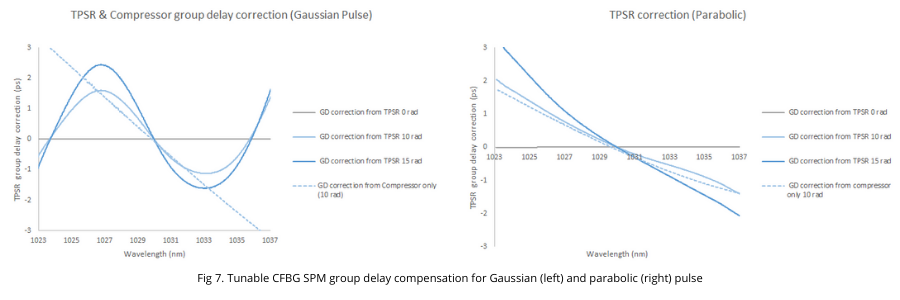
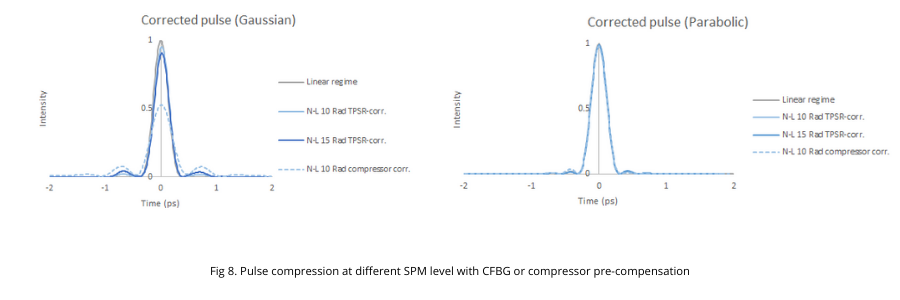
Conclusion
In summary, there are several ways to offset the limitations in pulse compression caused by Self-Phase Modulation. Increasing the mode field diameter helps in reducing the SPM level; however, it may also impact the beam quality and beam pointing stability. This approach is also usually more expensive and requires more complicated fiber routing to maintain single-mode propagation. Moreover, optimizing the grating compressor is not efficient enough to compensate for the non-linear effects for most pulse shapes because the high orders of dispersion remain unmatched after optimization.
Tunable CFBGs offer a precise and simple solution to properly compensate for SPM and its impacts on pulse degradation. The SPM offset is possible to well over 10 rad of accumulated non-linear phase, ensuring a proper pulse compression thorough the whole energy range that is extracted from the amplification chain.
Support and Resources
Building an ultrafast laser is a challenging task that becomes much easier when doing it with the right partners. Please contact ultrafast@teraxion.com to help you select the appropriate components for your lasers and targeted market.
Related Products

TPSR-Xtended Tunable Pulse Stretcher for High-Energy Ultrafast Lasers

TPSR Tunable Pulse Stretcher for Ultrafast Lasers

